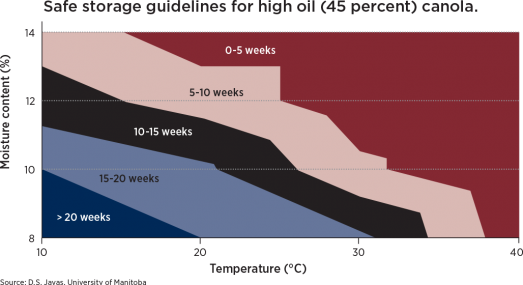Store it, but don’t forget it
After escaping all the yield loss traps in the field, there is one more obstacle to overcome before delivering canola to the elevator: storage. Grain mismanaged in a bin can result in disappointing losses. Paying attention to the moisture and temperature of the grain as well as outdoors is critical to management.
Canola storage was the focus of Joy Agnew’s group at the Prairie Agricultural Machinery Institute (PAMI) this past summer. In collaboration with the Canola Council of Canada (CCC) and the provincial canola grower organiza-tions, she monitored temperatures and relative humidity of three canola bins throughout the summer to determine best management strategies for summer storage. Agnew’s project began in the winter, turning on aeration fans in temperatures below -30°C to freeze the canola. Nine temperature and humidity sensors were inserted into the bins in early June, using long probes for minimal grain disturbance, and monitored until removed.
The three bins used in this study each had their own treatments. One was left alone, one was turned in early June and one had the fans turned on at night beginning in mid-June. Preliminary results indicate that if frozen (due to the conditions experienced in early 2014), canola is best left alone to safely store throughout the summer.
The most critical thing to remember about storage management is to check your grain often. Heating, high moisture or pest problems can develop quickly if the grain is not under regular surveillance. Watching the temperatures change with the PAMI project supports this. To read a blog of Agnew’s results, go to www.canolawatch.org and search for “Blog: Canola bin watch.”
Heat isn’t the only concern with stored canola. Microflora infestations can be a problem too. Fuji Jian et al’s 2014 study determined that canola seed at 14 percent moisture was able to support a variety of microorganisms at each of three storage conditions (20°C non-airtight, 30°C non-airtight, and 30°C airtight), with greater infestations in the non-airtight conditions. These organisms can contribute to heat production and reduce grain quality. The spoilage risk is lower for cool and dry canola, with eight percent moisture and temperatures below 15°C considered safer for long-term storage.

Aside from traditional bin storage, research on short-term storage bags suggests they are a viable option. Digvir Jayas, a researcher at the University of Manitoba, continues to test the limits for storing canola in these large grain bags. He has found that canola can be safely stored for over 10 months at moisture levels of eight and 10 percent.
For further storage details, read the storage chapter at www.canolacouncil.org/canola-encyclopedia.”




